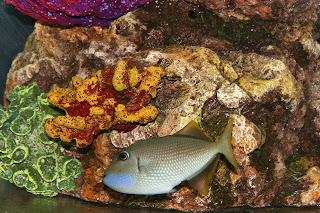I wish I didn't have to bother with negative news. But, it's only fair to balance the blog with all sorts of news of the goings on in my reef. So, here it goes:
Even though I selected him for his different body shape and colors, the
Blue Throat Trigger had a bit of a tough time in my reef tank. It was revealed that
Adebisi (
I wanted to name all my fish after the characters in Oz at some point), the Purple Tang, had asserted himself as the queen bee of the tank and had his misgivings about the trigger. I noticed that the trigger was allotted the left side of the tank where he was allowed to swim figure eights around the two Vortechs nearby.
I noticed that the few small patches of "fin rot" were clearing up on the trigger. Maybe he was getting a midnight cleaning treatment from the coral banded shrimp or skunk shrimp? Or maybe the water quality and circulation was better in the main tank rather than in the quarantine tank (he stayed at least 5 weeks there)?
From afar, things looked like they were going well. But whenever I would get closer to the tank, Adebisi would become more aggressive and try to use his special scalpel weapon on the trigger. The behavior reminded me of a dog becoming aggressive to other dogs when a treat was about to be given out. I doubted that I could use any advice from
The Dog Whisperer because the fish wouldn’t be able to hear my “CHT!” through the tank.
The day came when I finally realized that the trigger had truly disappeared. I knew the night before that I noticed he was missing. There was nothing I could have done because some friends had visited and we were going out for
December Nights in Balboa Park. So, while I was chowing down on funnel cakes drenched in strawberry preserves and whipped cream and an orange chicken rice bowl washed down with hot chocolate and enjoying the festivities, my blue throat trigger had gone carpet surfing.
I had given him a few days to magically reappear so that everything would be all right. Then, I pulled out my flashlight and went on a search. First, I checked the surrounding carpet. I checked under the sofa and chairs in the living room because I’ve read that some fish may surf across the room. Usually, in the stories, it’s found that their pet cat is the culprit. I don’t have any pets, so he’d have to get across the room by a human’s foot kicking action. I tried to simply use my sensitive nose and it lead me to the sump area. No where to be found, I then checked the back of the tank setup.
There, amongst the shadows of Vortech, battery backup, ATO wires and refugium tubing, I saw a small shape at the bottom. The access to the area was 4 feet from the side and two feet from above and my arms did not fit. So, even if I had located the trigger on time, I would have probably had to kill him in the process of retrieving him. I was able to use my 2 foot
“multi-tool” tongs to whack the body around until I was able to clamp down on it.
When I examined the body with its sunken eyes and trigger fin fixed in the up position, my first impression was “fish jerky”. I didn’t want to snap a picture of him for the blog. I used him, instead, as fertilizer for the yet-to-arrive, new fruit trees in the back yard.
 PS: the pipefish are gone as well; I couldn’t keep up with their demands for fresh baby brine shrimp every day. The baby Bangai Cardinal still lives, though. There is still hope, Mr. Frodo.
PS: the pipefish are gone as well; I couldn’t keep up with their demands for fresh baby brine shrimp every day. The baby Bangai Cardinal still lives, though. There is still hope, Mr. Frodo.












































